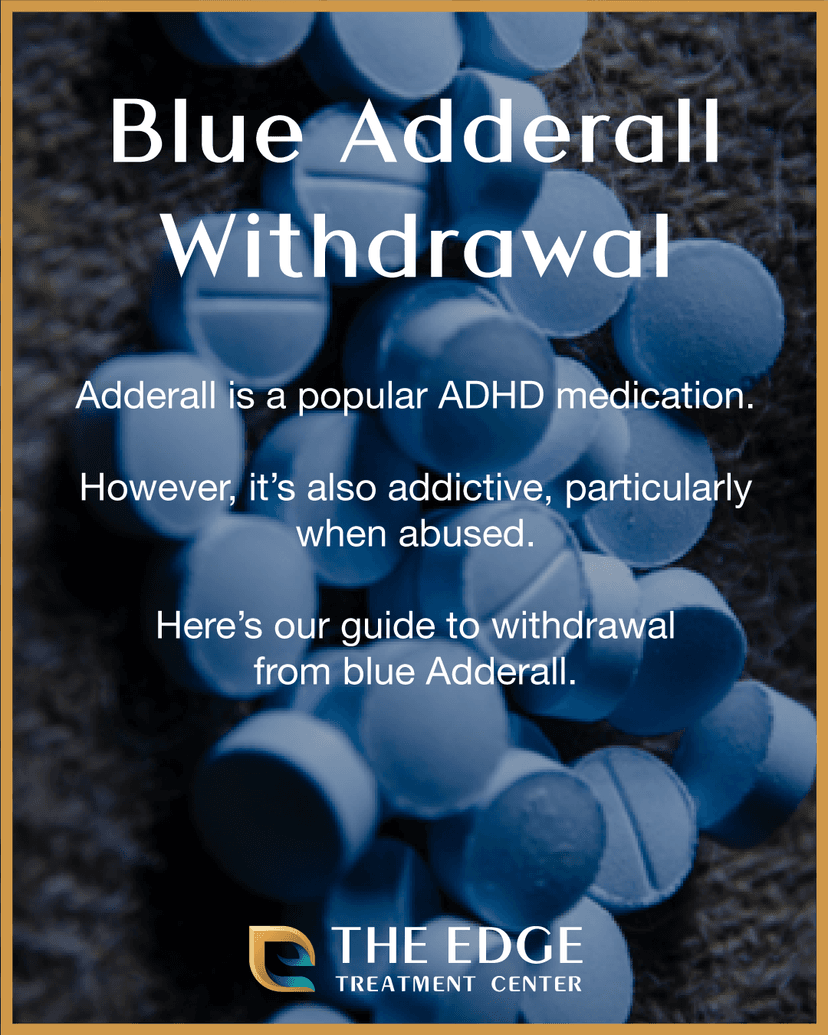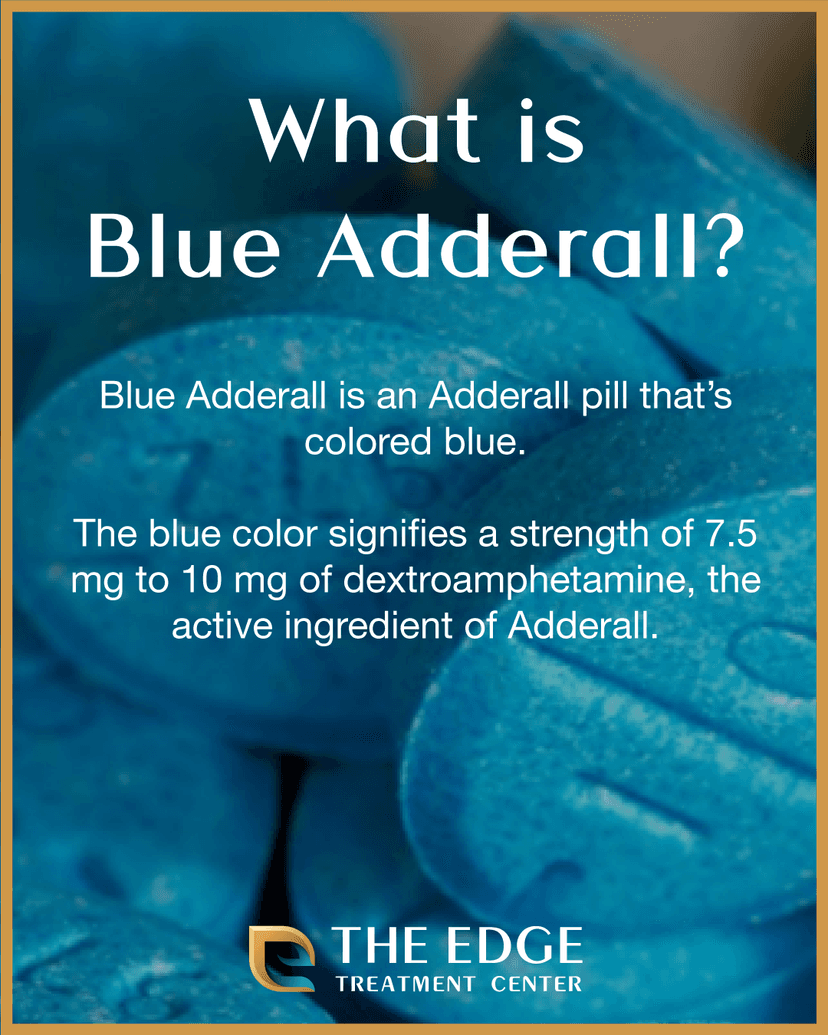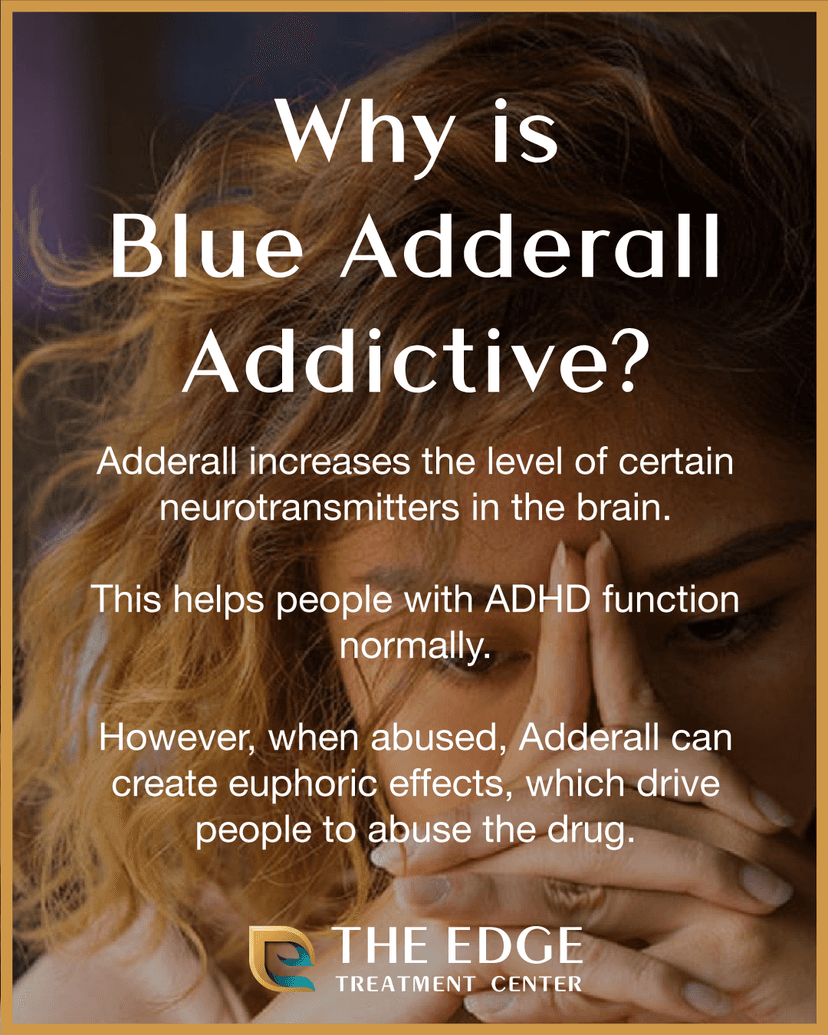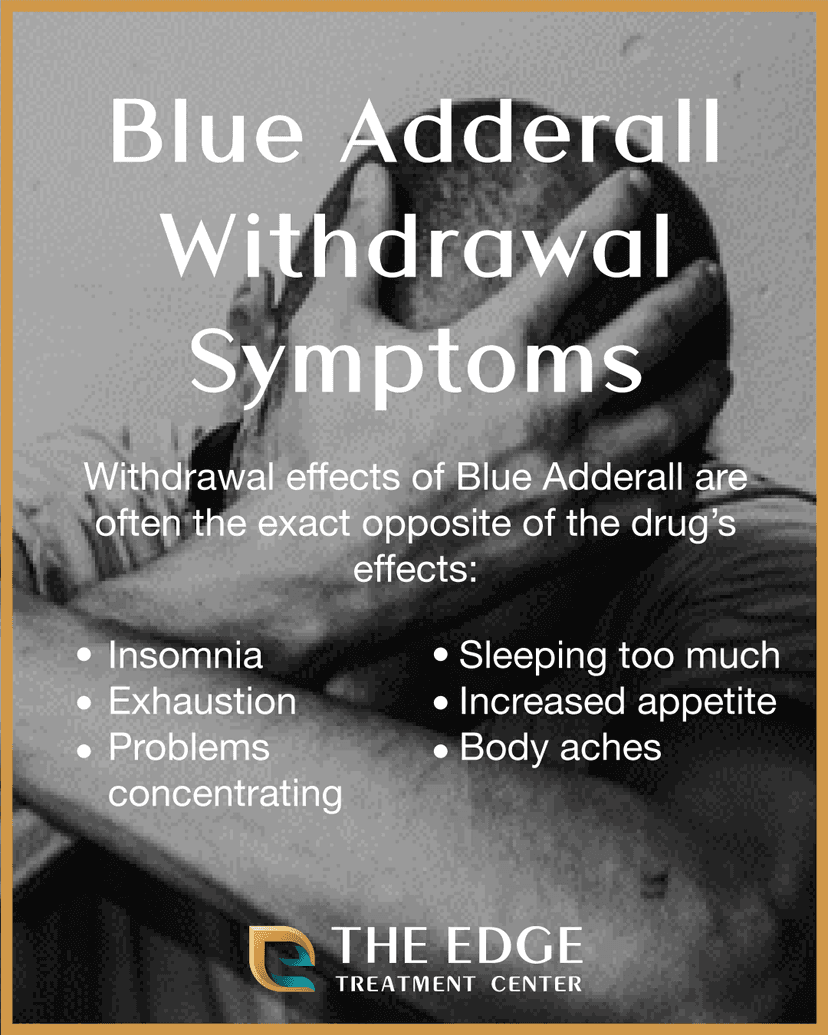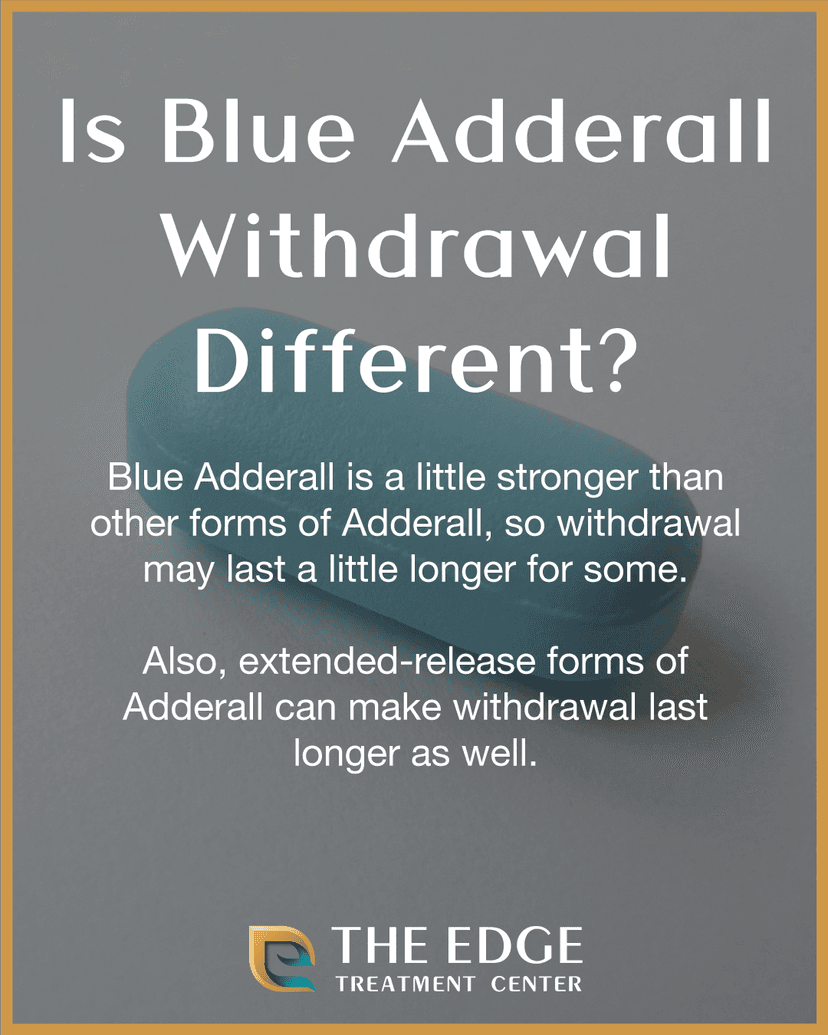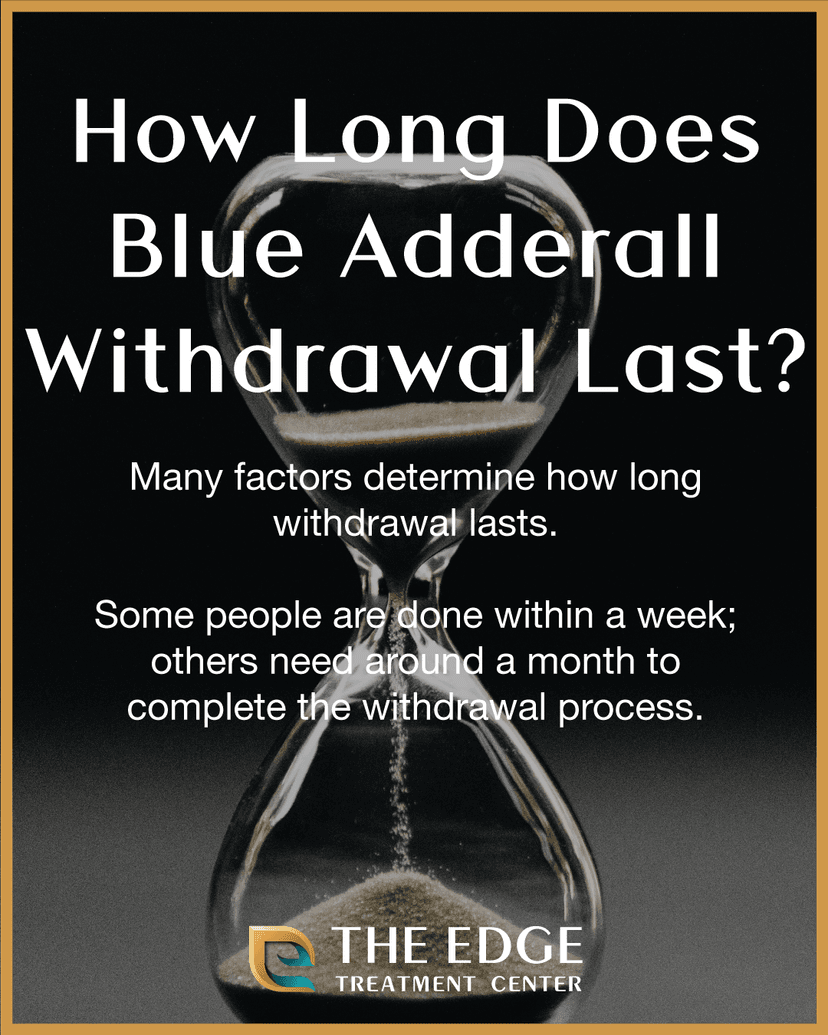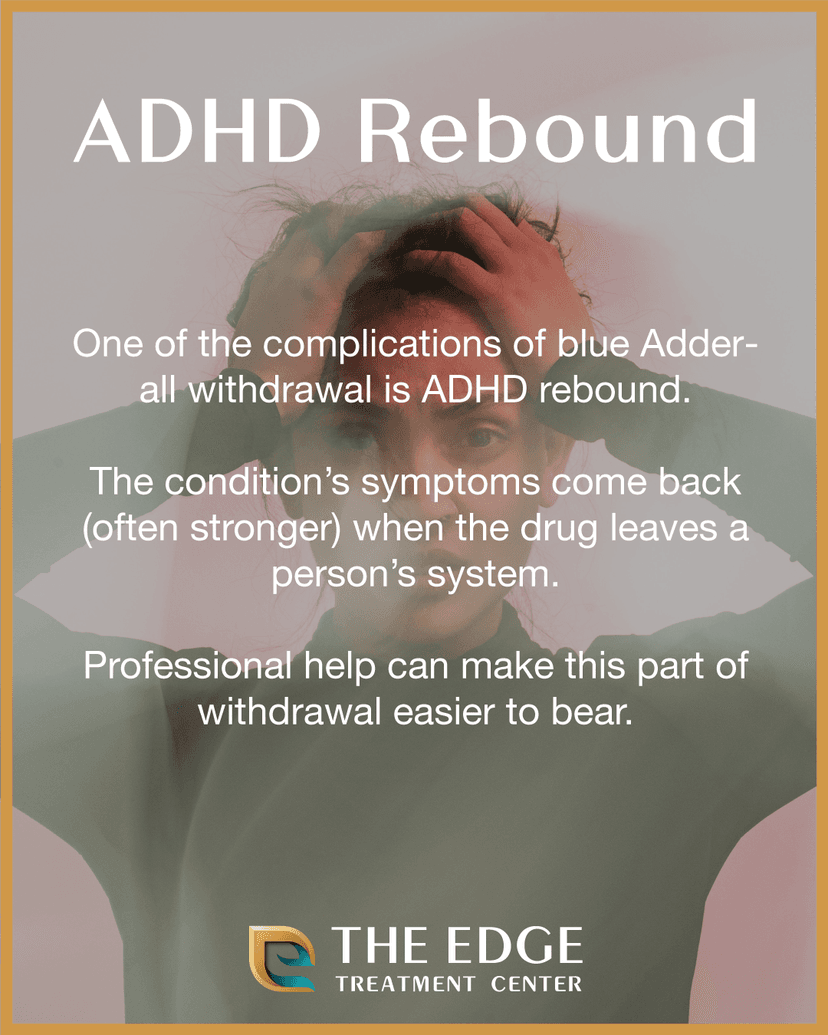Drug and Alcohol
Blue Adderall: Side Effects, Withdrawal Symptoms, & More

Do you know what Blue Adderall is? Learn about addiction to this powerful ADHD medication in our blog. The Edge treats addiction to Adderall and more.
Adderall is a stimulant used by doctors to treat attention deficit hyperactivity disorder (ADHD). This psychological condition makes the brain lose focus, become hyperactive, and behave erratically, as well as narcolepsy, a chronic sleep disorder that causes pressing fatigue and drowsiness. By promoting focus and attention, Adderall can effectively address these issues.
Nevertheless, Adderall, like other amphetamines, is also a commonly misused substance. In the black market, it is known by various names, including uppers, beans, speed, black beauties, and more. ADHD medications like Adderall are often abused as "study drugs" by students looking for an edge on exams, or to power through cram sessions.
High doses of this medication can produce a euphoric feeling similar to illegal stimulants like methamphetamine and heroin. Adderall is also used to enhance performance. It is sometimes referred to as a "study drug" because of the deceptive impression that it improves attention and focus in people who do not have ADHD.
Like other prescription drugs, Adderall should only be used under the guidance of a doctor who is familiar with your medical history and who can prescribe the right dosage for you. Adderall is purchasable under brand names such as:
Adderall
Adderall XR
Mydayis
These prescription Adderall pills can be divided into two major classes- immediate release and extended-release. Immediate-release Adderall is commonly administered as an oral tablet, while extended-release Adderall is usually in capsule form for oral consumption.
By the Numbers:
According to a 2018 poll by the National Institute on Drug Abuse, 6.6% of American adults took prescription stimulants in the previous year; 4.5% used them appropriately; 2.1% abused them at least once; and 0.2% had prescription stimulant use disorders.
What Is Blue Adderall?
Blue Adderall is essentially Adderall but is colored blue. It's the same medication made up of dextroamphetamine. Small and oval-shaped blue Adderall pills have an immediate-release formulation and come in 7.5mg doses. Round blue Adderall pills, on the other hand, have a higher dose of 10mg but the same release formulation. Adderall XR, also known as the blue Adderall capsule, has an extended-release formulation, meaning it is effective for a longer time than the pills.
The only major difference between the two kinds of blue Adderall is the pills' shape, formation, and release times. The round or oval pills last approximately 5 hours and are often prescribed to be taken 3 to 4 times daily. The extended-release blue Adderall capsules, however, can last for up to 10 hours.
Are There Other Colors of Adderall?
Yes, Adderall pills come in a variety of colors, including:
White 5mg Adderall pills
Blue 7.5 or 10mg Adderall pills
Yellow 12.5, 15, 20, or 30 mg Adderall pills
Should I Take Blue Adderall?
Blue Adderall is a prescription drug, and if you don't have a prescription for Adderall, don't take it. Misusing prescription drugs is drug abuse. Adderall can also be harmful to people with certain conditions, which include:
Anxiety
Hyperthyroidism
Severe high blood pressure
Glaucoma
Pregnancy
Epilepsy
Allergy to Adderall
Adderall also has potentially harmful interactions with other drugs:
SSRIs, MAOIs (monoamine oxidase inhibitors), and other antidepressants
Sympathomimetic drugs
Propoxyphene

We’re Here To Help You Find Your Way
Would you like more information about Blue Adderall? Reach out today.
Side Effects of Blue Adderall
A doctor typically prescribes blue Adderall to patients who need it, but it is also widely misused. Regrettably, it is common for users to get hooked on blue Adderall without realizing it. With time, the consumer's tolerance to the stimulant may grow, requiring bigger doses to achieve the same results. Drug addiction develops as the dose is increased and the tolerance threshold is pushed.
This is why it is crucial to always check with your doctor before altering your dosage if you feel like your medicine is not working as well as it did when you first started taking it or if it seems ineffective.
Some people solely use the drug for its calming and euphoric effects. These folks frequently look for persons from whom they might 'steal' medicine or turn to illicit means to obtain it. People might also do this to feel calmer, focus, or perform better at work or school.
Taken on the advisement of a healthcare professional or not, blue Adderall has several side effects, including:
Mood swings
Irritability
Anxiousness
Nervousness
Abdominal pain
Migraines
Nausea
Fever
Vomiting
High blood pressure
Constipation
Distorted/blurry eyesight
Sexual dysfunction
Reduced sexual appetite
Unexplained hair loss
Even if you are only taking blue Adderall because you need it and are following the prescribed dosage, the use of Adderall and other prescription stimulants can still result in side effects and complications. However, abusing blue Adderall and taking it excessively to feel high can lead to even more severe harm.
How Does Blue Adderall Work?
Neurotransmitters are chemicals our brains use to help send messages to different areas of our bodies. These chemicals travel between nerve cells and bind to certain areas on them. This triggers an action by the nerve cell.
Two neurotransmitters, norepinephrine, and dopamine, are involved in actions like memory and being able to concentrate. People who have ADHD may have levels of dopamine and norepinephrine that are unbalanced, which is why they experience symptoms of ADHD. Adderall increases the levels of these neurotransmitters, which is why a stimulant like Adderall can have a calming, focusing effect on someone with ADHD.

We’ll Lead You to New Heights
Do you have more questions about Blue Adderall? Reach out.
Withdrawal Symptoms of Blue Adderall
As is the case with all CNS prescription-based or non-prescription-based stimulants, Blue Adderall should only be used temporarily. Even doctors do not recommend patients use it regularly for a long time. Extensive or long-term usage of blue Adderall could cause major physical and mental issues.
But, when someone tries to quit or reduce their usage of blue Adderall abruptly, it can trigger a range of physical and psychological withdrawal symptoms, mainly if they have developed an addiction to the drug:
Restlessness
Panic attacks
Fatigue/tiredness
Disturbed sleep cycle
Suicidal thoughts
Muscle aches
Sweating
To prevent withdrawal symptoms, doctors generally taper the dosage of blue Adderall gradually, ensuring that the body is not suddenly deprived of the medication. While addiction to the substance is of concern, it can be successfully addressed by professionals at a good rehabilitation facility. With medical drug detox, withdrawal symptoms associated with Adderall can be effectively managed, minimizing discomfort and the risk of relapse.
The severity of the withdrawal symptoms indicates that blue Adderall must be consumed carefully. You should take it as and when recommended by a medical practitioner, and do not change your dose without discussing it with your doctor or psychiatrist. Even when you miss a dose, do not make the mistake of doubling up on it.
And lastly, never take blue Adderall or any similar stimulants unless they are prescribed to you by your doctor.
After abusing too much blue Adderall, even for once, withdrawal symptoms might not be too bad, but they can still be uncomfortable. Even after a few short-term uses, the body can start feeling used to the substance. In such cases, it is common for people to end up using more blue Adderall to make themselves feel better.
Blue Adderall: ADHD Rebound
A common side effect of withdrawal from blue Adderall and other ADHD meds is ADHD rebound. When blue Adderall or another prescription stimulant like Klonopin leaves the body, it's not uncommon for a person to feel the effects of ADHD in a slightly stronger form once they're no longer under the effects of blue Adderall.
ADHD rebound can be managed during professional drug rehab, however.
How Long Do Blue Adderall Withdrawal Symptoms Last?
In most cases, withdrawal symptoms show up within one to three days after you stop using it. Depending on the person, they can last anywhere from a few days to a few weeks. Your mind and body may have grown dependent on the medicine if you have used it for a long time. The more you use it, the more challenging it is to stop using it.
Other variables that may affect the duration and intensity of your discomfort and the timeframe of Blue Adderall withdrawal symptoms include:
Medical history
Mental health
Genes
Drug use in the family

We’re Here To Help You Find Your Way
Do you need advice about Blue Adderall? Reach out today.
Taking Care of Withdrawal Symptoms
There is no specific method for stopping the consumption of blue Adderall. If you wish to stop taking it, talk to your doctor about the best way. Some might suggest progressively lowering your dosage before stopping it altogether. Avoid attempting a "cold turkey" withdrawal. Usually, you can control the physiological side effects of withdrawal at home. If you still feel anxious or have suicidal thoughts, call your doctor or get immediate help from a medical professional.
How Long Does Blue Adderall Stay in Your System?
Every time blue Adderall enters the body, it first passes through the liver before being eliminated by the urine. Then, it enters the digestive system, undergoes liver metabolization, and exits through the urine. Despite leaving the body through urine, Adderall has various effects on the body and can be found in numerous tests. Let us first see how long the medication will stay in your system.
Blue Adderall in the Blood
The drug can still be found in the blood 46 hours after the last consumption. The simplest way to determine whether someone has taken blue Adderall is with a blood test.
Blue Adderall in Urine
The concentration of blue Adderall in the urine is always higher than anywhere else because this is where the drug is eventually gathered before it leaves the body. For a period of 48 to 72 hours following the last usage, a urine test can identify blue Adderall use.
Blue Adderall in Saliva
Saliva tests can detect the presence of blue Adderall in the body for up to 50 hours.

We’ll Lead You to New Heights
Would you like more information about Blue Adderall? Reach out today.
Blue Adderall in Hair
Although testing for drugs using hair samples is not the most common way, it can be the most effective for blue Adderall. This is because most drugs, including Adderall, can be detected through the hair even after 90 days (3 months) of last use.
What Factors Affect How Long Blue Adderall Stays in the Body?
Type of Doses
Blue Adderall is available in different strengths and potencies. It can be purchased in tablet or capsule form. The time the body requires to break down the drug completely can increase with higher doses, resulting in longer drug retention. Blue Adderall, as we mentioned earlier, is available in extended and immediate-release variations, which are processed differently by the body. The formulations can also influence how long the drug remains in your body.
Body Composition
It is common knowledge that larger people require higher doses of medication to provide the intended and effective effects. The amount of time a medicine stays in your bloodstream is strongly influenced by the makeup of your body. Height, body weight, and total weight should all be considered.
Metabolism Rate
Each body is unique, and so is its operation. Each person's organs have a unique mix of enzymes. For instance, your liver's enzymes are in charge of breaking down the prescriptions you take. Your gender, how much you exercise, nutrition, the medicines you take, and other factors can all impact your metabolism rate.
The length of time blue Adderall remains in your body is thus substantially influenced by your metabolism rate.
Your Age
With age, it is very common for medication to start taking longer to leave your system. There are a few different reasons for this, such as:
Your liver's size will shrink, taking longer to break down Blue Adderall completely.
Age-related illnesses, including heart disease, can also decrease urine output and renal function. In addition, when drugs leave the body through the urine, a decrease in urine production extends the time they remain in the body.
As you age, your body's makeup may change, impacting how quickly your body breaks down and gets rid of medications.
How Well Your Organs Function
The absorption of blue Adderall takes place in various body organs. It first goes through the gastrointestinal tract, after which it undergoes metabolism by the liver. Once completely broken down, the drug gets excreted through the kidneys. Suppose there is any problem with any of these organs in your body. In that case, it will not be able to carry out its function effectively enough to eliminate the blue Adderall from the body at an average time – it may take much longer.
Why Should You Stop Abusing Blue Adderall?
People often consider blue Adderall and other prescribed medications as "secure" compared to other illegal stimulants since doctors commonly prescribe them. Blue Adderall is not taken seriously also because there is less stigma that comes with consuming a pill than inhaling or ingesting other substances or drinking alcohol. Nevertheless, Adderall usage, like other stimulants, can have many harmful health consequences, including:
Insomnia
High blood pressure
High body temperature
Loss of appetite
Tremors
Taking blue Adderall in large amounts or over a long period may result in dangerous side effects such as seizures, cardiac arrest, and schizophrenia. As a result, the US Food and Drug Administration (FDA) now mandates that all Adderall containers and counterfeit copies of the drug bear a disclaimer that overuse can result in significant heart conditions and abrupt death.
Can You Overdose on Blue Adderall?
Yes. Like any drug, it's possible to take more blue Adderall than your body can handle, which causes an overdose. Blue Adderall overdoses are potentially fatal. Symptoms of Adderall overdose include:
Rapid breathing
Seizures and/or convulsions
Hyperactivity
Muscle and body pains
Fast heart rate
High body temperature
Unconsciousness
Vomiting
If you or someone you know has overdosed on blue Adderall, call 911 immediately. In overdoses, minutes matter.
Blue Adderall Is Addictive. Break Addiction to Blue Adderal at The Edge Treatment Center
The Edge Treatment Center specializes in treating prescription medicine addiction, including opioids, anti-anxiety drugs, sedatives, and stimulants. We prioritize personalized care and treatment for our patients with the help of various evidence-based programs, plans, and methods. In addition, We offer access to many patient-specific support programs such as medical detox, rehabilitation, and ongoing supportive care. Our team of medically qualified professionals at The Edge offers compassionate care, mental support, and emotional assistance to every patient.
If you or a loved one is struggling with addiction to blue Adderall, The Edge Treatment Center is a great option. Seeking help and support for addiction is an essential step toward recovery. The Edge Treatment Center can provide the tools and resources to overcome addiction to ADHD medications. Reach out to us today to learn more.

We’re Here To Help You Find Your Way
If you or a loved one is struggling with addiction, there is hope. Our team can guide you on your journey to recovery. Call us today.
Written by
 Brian Moore
Brian MooreContent Writer
Reviewed by
 Jeremy Arzt
Jeremy ArztChief Clinical Officer
Drug and Alcohol
April 4, 2023

